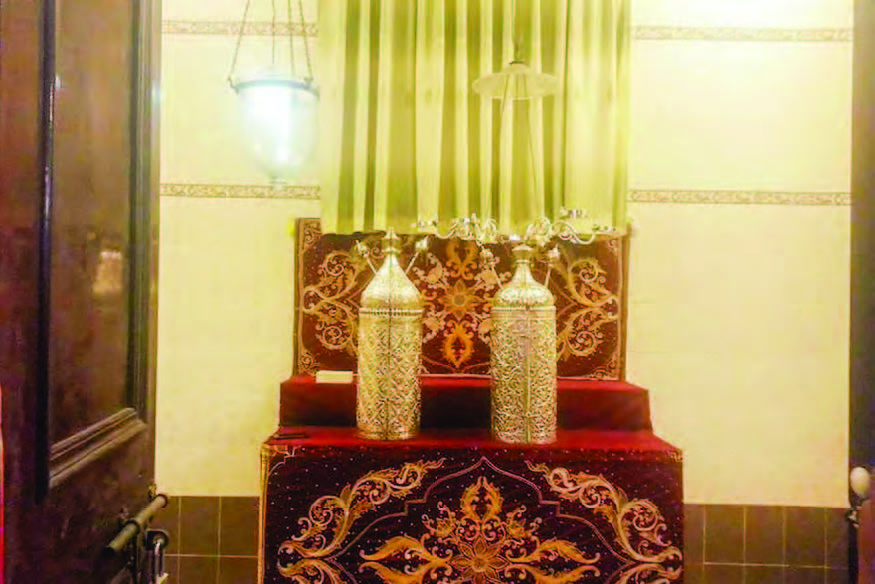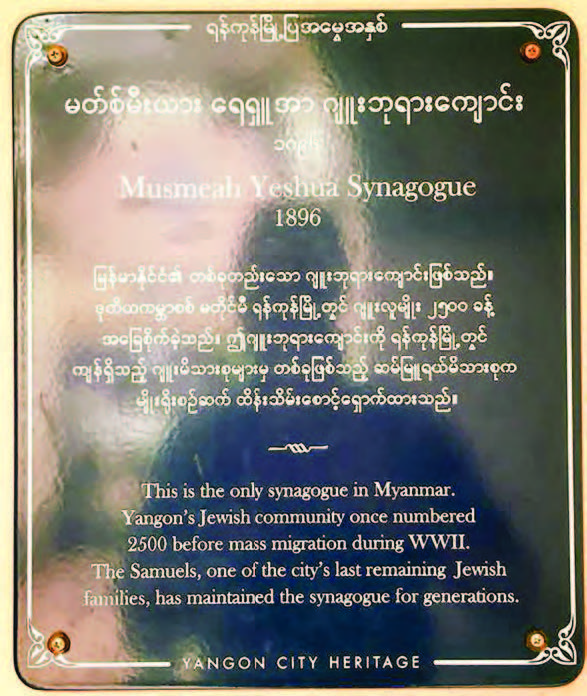May 16, 2020
By Maung Tha (Archaeology)
As Myanmar had been ruled by British colonialists for many years, there remain many residential buildings, offices, schools, Buddhist religious edifices, temples, churches, mosques and synagogues built in colonial era in Myanmar. Among them, number of buildings in Christianity is the largest in Yangon in addition to buildings for services held by those with faiths of Hindu, Islam, Sikh and Jew.
Currently, more than 100 years old buildings of these structures are included on the list of ancient buildings.
With regard to ancient buildings
According to the Law on the Preservation and Protection of Ancient Buildings, the buildings of more than 100 years old including the structures built and used by humans above and underground and above and underwater were set as ancient buildings. To be able to preserve historical heritages of buildings, the Ministry of Religious Affairs and Culture scrutinizes ancient structures across the nation to designate ancient buildings.
The Department of Archaeology and National Museum is carrying out search and maintenance of tangible and intangible cultural heritages from various areas of the nation. The published the books on such ancient buildings on locations and eras. Among 47 cultural heritage zones throughout the nation, Yangon Region is formed with 16 zones.
These zones in Yangon Region are locations of eminent religious edifices of Buddhists such as Shwedagon, Sule, Botahtaung, Shwephonepwint, Koehtetgyi and Kyaikkhauk pagodas.
Yangon Branch of Department of Archaeology and National Museum is searching and conducting research on the buildings with the works of colonial era in Yangon Region. In collecting ancient heritage buildings, the branch compiled the list of 120 more buildings decorated with works of colonial era in 14 townships of Yangon Region. According to a list compiled by Yangon City Development Committee, there are 188 ancient heritage buildings in Yangon.
Among eminent ancient buildings in Yangon, the Musmeah Yeshua Synagogue takes a position in downtown Yangon.
Yangon in the history
Mon ethnics established Dagon as a small fishery village in the place of current Yangon during the period from 1028 to 1043 AD. King Alaungphaya who established Konbaung dynasty cleaned the old Dagon on 2 May 1755 and established a new city on 75 acres of land. He named the city as Yangon built with teak logs as walls.
After the Second Anglo-Myanmar War, British occupied the lower Myanmar on 20 December 1852. Dr. W. Montgomery and Lt. A. Fraser drew a modern city project which centred Sule Pagoda so as to rebuild Yangon as a hub of lower Myanmar.
Based on the Reconstruction of Modern Rangoon 1863, British built Yangon in a Chess Board Pattern bordering with East Road (now Theinbyu Street) in the east, Lanmadaw in the west, Strand Road in the south and Commissioner Road (now Bogyoke Aung San Street) in the north. Five main roads stretching from the east to the west namely Strand Road, Merchant Street, Maha Bandoola Street, Anawrahta Street and Bogyoke Aung San Street were constructed with 180 feet in width. The westernmost street stretching from the south to the north was 17th street and the easternmost, 44th street.
Yangon City, 21 miles from the mouth of the sea, was built at the confluence of Yangon River, Bago River and Dawbon Creek. As such, it was an important port city. King Alaung Mintayar appointed Minhla Kyawswa as the governor of Yangon. British kept a signal line under the holy umbrella of Alanpya Pagoda built on a large plot near Shwedagon Pagoda and used such signal lines for vessels in Yangon River. As such, the pagoda was named Signal Pagoda or Sale’s Pagoda because British commander Sir Robert Henry Sale stationed his troops at the pagoda in the First Anglo-Myanmar War.

Jews in Myanmar
According to the records, the Jew who arrived in Myanmar firstly was Solomon Gabirol who served at the troop of King Alaung Mintaya in 18th century.
In mid-19th century when British governed Myanmar, Jew merchants from Iraq and India arrived in Myanmar and established Jewish communities in Yangon and Mandalay. In 1940, more than 2,500 Jews resided in Myanmar.
A Jewish cemetery with some 600 tombs was located on 91st street in Yangon. Likewise, one more Jewish cemetery took a position in Mandalay. Issac Samuels who passed away in 1978 was buried at the Jewish cemetery in Yangon. Issac was father of Moses Samuels who maintained the Musmeah Yeshua Synagogue and was buried as last remains at the Jewish cemetery.
A Jewish school set up in 1910 was attended by 200 students from the KG to the middle school level. Some Jewish men married Myanmar women and sent their offspring to India and Britain to study further learning.
Jews in Myanmar operated small scale industries as well as exportation of thread and rice in British colonial era. They established social societies in Yangon and Pathein. In early 20th century, they elected their leaders. Mr. Raphael was leader of Jews in Pathein and Mr. David Sophaer in Yangon.
Jews opened the Beth El Synagogue in Yangon in 1932. When Japanese troops occupied Myanmar, a large number of Jews left Myanmar for India. As such, the Beth El Synagogue was closed due to least number of prayers. However, the location and records for building related to the Beth El were not found.
Myanmar and Israel regained Independence in 1948. Myanmar among Southeast Asian countries recognized Israel as an independent country. Diplomatic relations between Myanmar and Israel was established in 1953 and embassies to each other opened in 1957.

Musmeah Yeshua
The Musmeah Yeshua Synagogue, one of the urban heritages in Yangon City, was established at No 85 on 26th street in Pabedan Township.
Pabedan Township formed with 11 wards takes a position of centre in Yangon. The area was resided by those engaged in blacksmiths in early Konbaung era. So the area was named Pabedan. When Shwedagon Pagoda was hoisted a holy umbrella by King Mindon, iron structures of the umbrella were made by blacksmiths U Sa and U Nyo from Pabedan Ward.
Complexes of Theingyi Market, Bogyoke Aung San Market, St. Mary Church, BEHS No 1 Pabedan and former head office of Myanma Railways in Pabedan Township were built in colonial era including the Musmeah Yeshua Synagogue building.
In 1854, Jews built a small wooden building for praying. In 1893, they dissolved the building and constructed the two-storey Musmeah Yeshua Synagogue taking three years till 1896. The land plot for the building was permitted by British government.
The Musmeah Yeshua stored 126 items of Torah Scroll for Jewish religion. As Jews who left Myanmar took these copies of Torah Scroll, the Musmeah Yeshua now holds two Torah Scroll copies only. These treatises taken from Baghdad of Iraq are more than 100 years old.
At present, the Synagogue becomes an urban heritage site in Yangon where globetrotters visit. The Synagogue is being maintained by generations of Moses Samuels who passed away on 29 May 2015.
Maintenance of the Synagogue was undertaken with financial assistance of the United States of America and it completed in 2013. On 8 December, the Synagogue hosted an interfaith friendship ceremony, attended by Union Minister at the President Office U Aung Min, US Ambassador to Myanmar Mr. Derek Mitchell and Israeli Ambassador Mr. Hagay Moshe Behar.
The Synagogue, a single one in Myanmar, was included on the list of 10 top destinations for foreign tourists in Yangon. The Yangon Heritage Trust-YHT installed the 13th blue plaque at the Musmeah Yeshua Synagogue in Yangon on 6 June 2016.
Documentary photos on Myanmar-Israeli relations are put on display the Synagogue whereas the two copies of Torah Scroll are being preserved. The synagogue built 125 years ago becomes ancient building as well as eminent heritage in Yangon.
The Musmeah Yeshua Synagogue is opened from 9:30 am to 2:30 pm daily except Sunday for public observation.
(Translated by Than Tun Aung)
References:
Myanmar Encyclopaedia Volume XI
City Yangon (Maung Myat Mon, Sule)
The Last Jews in India and Burma (Nathan Katz and Ellen S. Goldberg)



